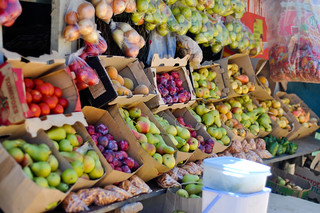Africa’s Fastest Urbanization Is Changing What People Eat — And How Farmers Survive
Urbanization Is Changing Africa’s Food: How Cities Reshape Farming and Diets
 |
| Farming While Happy |
In Africa, Small-Scale Farming Still Feeds Millions — But Urbanization Is Changing Diets
Africa is urbanizing faster than any other continent. Rapid urban growth has brought new opportunities but also inequality, poverty, slums, and a shift toward “urbanized food” — highly processed and imported foods that replace traditional staples. This transition deeply affects Africa’s small farmers and ranchers.
Most of the continent still depends on small-scale agriculture for food. Yet poor rural infrastructure — from roads to cold storage — makes it hard for farmers to reach growing city markets. As the demand for food rises and the farming sector shrinks, diets are moving away from indigenous staples like millet, sorghum, teff, and yams toward refined grains and processed foods.

In 1960, only 22% of the world’s people lived in cities; by 2015 that figure had jumped to 49%. Africa’s urban population grew from 470 million in 2015 to a projected 770 million by 2030 — the fastest urbanization rate in the world.
About 60% of Africa’s urban food demand now comes from small cities and towns. Traditional foods — yam, sorghum, millet, teff — have been cultivated for thousands of years with little change to hand tools for threshing and milling. But urban households with higher incomes increasingly choose dairy, fish, meat, fruits, vegetables, and processed foods over local staples.
Family farming still dominates Africa. Rural diets are shaped by subsistence farming tied to geography: rice in some regions, wheat with fruits and vegetables in others. But as people leave farming and seek non-farm jobs — often migrating to cities — the local food supply weakens. Meeting urban demand for fresh produce, dairy, and meat requires roads, cold storage, and reliable transport that many rural areas lack.

Without better infrastructure, urban areas will continue to rely heavily on imported foods and processed products. This contributes to both malnutrition and obesity: inexpensive, calorie-dense foods fill stomachs but lack essential nutrients.
Africa’s potential is enormous. Agriculture employs 65% of the labor force and contributes 32% of GDP. With the right investments — better roads, storage, and fair markets — small farmers could feed booming cities and reduce hunger.
Hunger and Food Insecurity
Hunger is the physical discomfort caused by not eating enough calories regularly. Over 821 million people worldwide experience hunger, and in Africa, conflict, economic slowdown, and climate change (droughts, floods, unpredictable rain) drive food crises.
Food insecurity means lacking reliable access to safe, nutritious food for a healthy life. Severe food insecurity means going a day or more without eating; moderate food insecurity means sacrificing other needs to afford food or relying on cheap, nutrient-poor options.

Living with food insecurity can cause long-term health problems. Stress and poor diet contribute to both undernutrition and rising obesity rates. Children who grow up hungry are more likely to face chronic disease later in life.
The Pressure on Small Farmers
Policies that reshape land use and farming systems directly affect Africa’s food supply. Smallholders are being asked to feed cities, maintain their own households, and produce cash crops for export — often without more land, labor, or technology. These pressures risk deepening food insecurity if not paired with support for rural development.
Urbanization Is Reshaping Africa’s Diets
Africa’s cities are growing faster than anywhere else in the world. As rural residents move to towns and cities, diets shift from traditional staples like millet, sorghum, yams, and teff toward refined grains, processed foods, and imported products.
This shift isn’t just about taste — it’s driven by income growth, lack of rural infrastructure for fresh foods, and the aggressive expansion of global food companies into African markets.
Without investment in local storage, cold transport, and fair markets, Africa’s small farmers risk being left behind while urban households depend more on imported, processed food.































